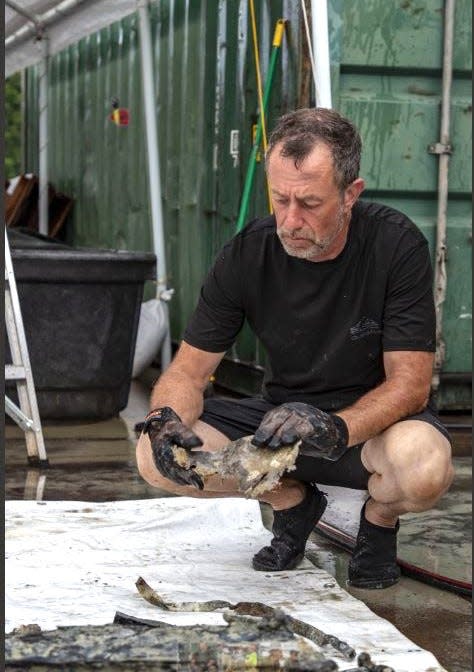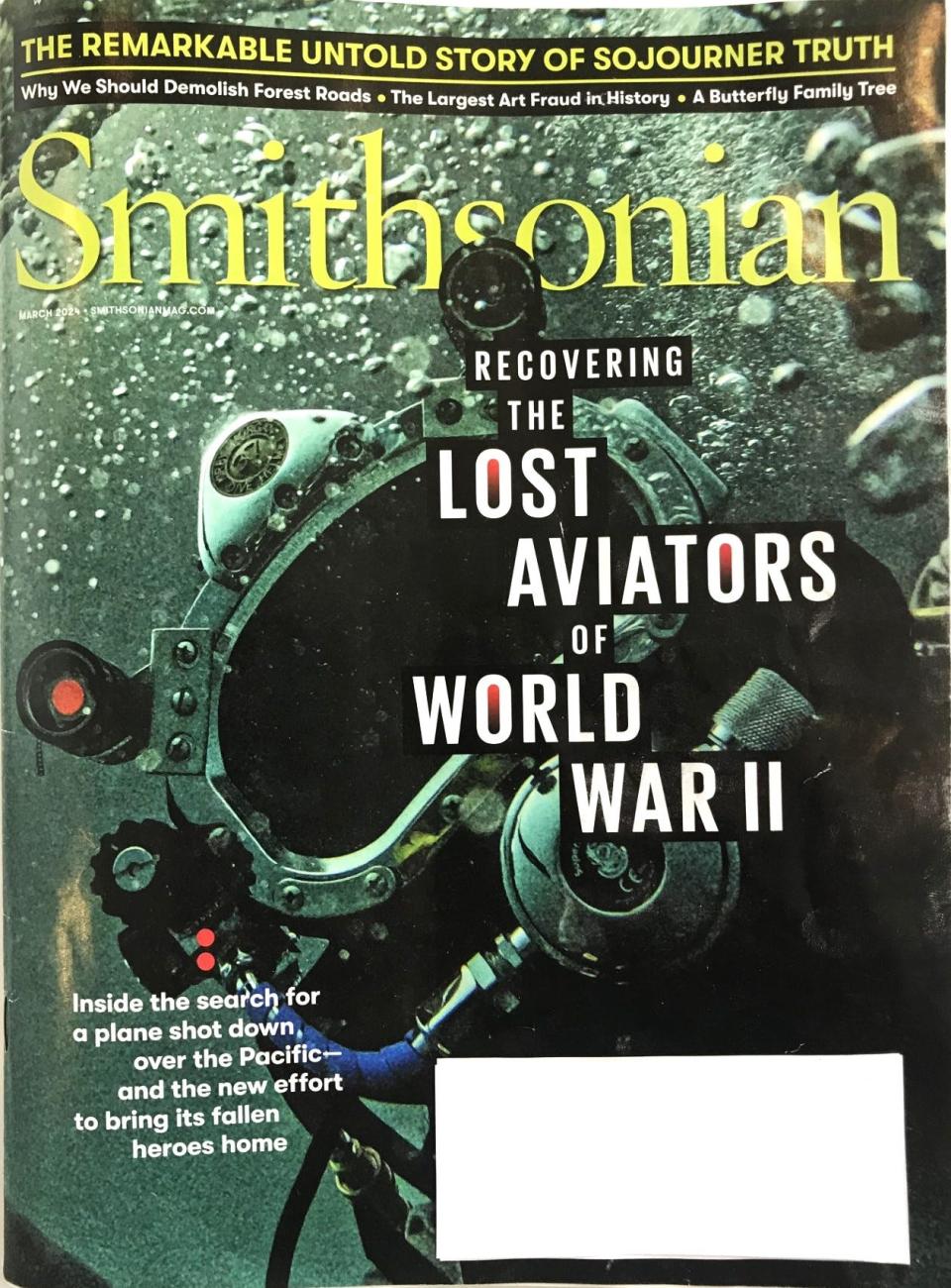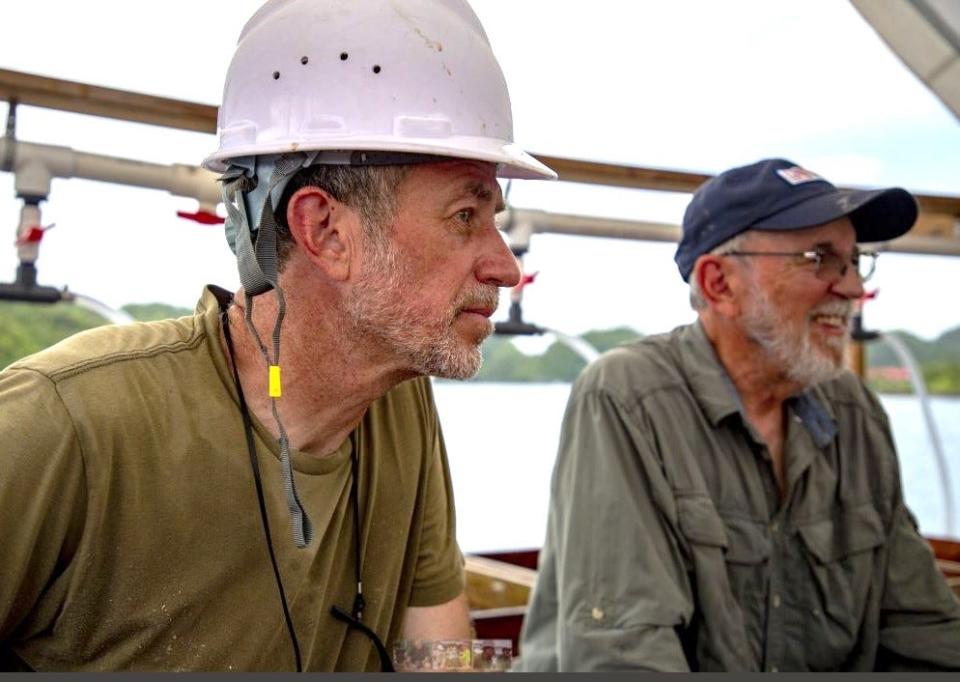UGA professor chronicles search for MIA soldiers in the ocean's depths for Smithsonian magazine

Stephen Mihm teaches history at the University of Georgia and grows heirloom apples on his Oconee County farm, but in 2023 he became a journeyman on a mission to search the ocean depths for soldiers who disappeared in a fierce battle of World War II.
“I was there from the beginning until the end – a little over three weeks,” said Mihm, who returned home with new skills and a respect for those dedicated to finding soldiers listed as missing in action.
Mihm was there specifically to chronicle the search for three men presumed killed when their bomber, known as an Grumman Avenger, was shot down by the Japanese along the Palau Islands of the South Pacific. A seasoned writer, he has written books, and had articles published in many outlets from magazines to newspapers such as The New York Times.
What he documented became an article in the March issue of Smithsonian, a magazine of science and history published since 1970. The article, “Recovering the Lost Aviators of World War II,” is also the magazine’s cover story.

Not only was the story written by a UGA professor, but the article highlights the work of Dr. Patrick Scannon, who graduated from UGA in 1969 with a degree in chemistry. He later earned his medical degree and took his medical talents to California, where he formed a private company.
Scannon in his later years founded an organization called Project Recover, which is dedicated to the search for MIA soldiers. Through this venture, he and Mihm would cross paths.
“He’s a very cerebral almost professorial person,” Mihm said. “Because he was trained as a medical doctor, he has what we call a good bedside manner in dealing with people. It was interesting watching him manage the operation.”
“I went with him one day to the capital of Palau to get a permit. That alone was fascinating to me,” said Mihm, who also serves in management at UGA as head of the history department.
Art of detection: Little known, reclusive author of detective novel in Athens passes away at 75
The recovery mission was designed to locate any remains of the three men who died when their bomber was shot down on Sept. 10, 1944, off the coast of Peleliu Island. The article details that pilot Lt. Jay R. Manown Jr., gunner Anthony Petta and navigator Wilbur Mitts were aboard.
Scannon along with numerous others participating in the operation were hellbent upon recovering their remains and taking their names off the ledger called MIA – missing in action.
Mihm, who said he was already familiar with a U.S. government agency that conducts similar search operations, said it was in early 2023 that he met the Georgia alumnus during a visit Scannon made to UGA.
“I had not been familiar with his operation, probably the largest private operation in the world dedicated to this,” Mihm said. The history professor suggested to Scannon that he would be interested in shadowing the group on their pending search mission.
“He said, ‘Why don’t you come along?” So, I signed up,” Mihm said. “I was a participant observer, meaning I tried to make myself as useful as possible."
Athens: Athens native Michael Thurmond writes book on Georgia's founder and his opposition to slavery
But Scannon, who is visiting UGA later this month, said Mihm was more than a writer collecting notes for an article.
“He chipped right in. He was one of the hardest working guys there. He could have just sat on a bench and took notes, but that wasn’t Stephen. He really wanted to participate, so we let him,” Scannon said.
And the writing also stood out.
“Stephen did a fantastic job. I’ve never seen better writing that describes what we did,” Scannon said. “He very much pointed out that it’s a team effort.”
Derek Abby, an Oregon resident who is now president of Project Recover and is coming to Athens with Scannon, said the article had an immediate impact.
“Smithsonian magazine has a wide distribution so many people have contacted us expressing their support. We’ve had families reach out after reading it and wanting to share information about their loved one,” he said. “Stephen did such a good job of making the reader feel like they are there with us on the mission.”

Abby’s personal motivation for conducting these operations to find MIAs has changed over the years. A former U.S. Marine and fighter pilot, he met Scannon at a World War II reunion, where they talked about the recovery project. Their mission, he said, “aligned with my values. It seemed like the right thing to do, so I came on board.”
Today, he is motivated by the desire to have families reunited with these missing soldiers and giving them a chance to experience that grieving process, something often missing when the mystery remains of what happened to the person.
“It’s absolutely incredible to witness. It is unique to families that have someone who went missing,” Abby said.
Manown’s bomber went down during a time the U.S. was trying to wrest control of these Pacific islands from the Japanese.
Parts of the missing bomber were first located by the recovery team in 2003.
“And here is 21 years later and we’re doing a recovery mission. It points to how long these processes take,” Scannon said.
Mihm described the islands, such as Peleliu, as “eerie.”
“You’ll see remnants and relics everywhere,” he said about the mid-20th century machines of war left rusting in place after the war ended.
And somewhere on the ocean floor are the remains of missing soldiers seemingly loss forever.
Mihm said he was most impressed with how these team members of various backgrounds had worked closely together. But he said one recovery mission only leads to another.
“Most of the team, after the Peleliu operation, were going on to the Marshall Islands,” said the professor, who held in his hands the eroding fragments of a distant war.
This article originally appeared on Athens Banner-Herald: UGA history professor writes Smithsonian article on search for MIAs

